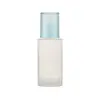What's inside
What's inside
 Key Ingredients
Key Ingredients

 Benefits
Benefits

 Concerns
Concerns

 Ingredients Side-by-side
Ingredients Side-by-side

Water
Skin ConditioningGlycerin
HumectantPropanediol
SolventNiacinamide
SmoothingPentylene Glycol
Skin Conditioning1,2-Hexanediol
Skin ConditioningMalus Domestica Fruit Extract
AntioxidantNymphaea Caerulea Flower Extract
Skin ConditioningAmmonium Acryloyldimethyltaurate/Vp Copolymer
C12-14 Alketh-12
EmulsifyingBetaine
HumectantHydroxyethyl Acrylate/Sodium Acryloyldimethyl Taurate Copolymer
Emulsion StabilisingPvp
Emulsion StabilisingHydroxyacetophenone
AntioxidantAcrylates/C10-30 Alkyl Acrylate Crosspolymer
Emulsion StabilisingTromethamine
BufferingAdenosine
Skin ConditioningTrisodium Ethylenediamine Disuccinate
Glyceryl Acrylate/Acrylic Acid Copolymer
HumectantBakuchiol
AntimicrobialPropylene Glycol
HumectantTrisodium EDTA
Parfum
MaskingWater, Glycerin, Propanediol, Niacinamide, Pentylene Glycol, 1,2-Hexanediol, Malus Domestica Fruit Extract, Nymphaea Caerulea Flower Extract, Ammonium Acryloyldimethyltaurate/Vp Copolymer, C12-14 Alketh-12, Betaine, Hydroxyethyl Acrylate/Sodium Acryloyldimethyl Taurate Copolymer, Pvp, Hydroxyacetophenone, Acrylates/C10-30 Alkyl Acrylate Crosspolymer, Tromethamine, Adenosine, Trisodium Ethylenediamine Disuccinate, Glyceryl Acrylate/Acrylic Acid Copolymer, Bakuchiol, Propylene Glycol, Trisodium EDTA, Parfum
Cyclopentasiloxane
EmollientWater
Skin ConditioningHdi/Trimethylol Hexyllactone Crosspolymer
Isododecane
EmollientDimethicone
EmollientPEG-10 Dimethicone
Skin ConditioningDimethicone Crosspolymer
Emulsion StabilisingButylene Glycol
HumectantVinyl Dimethicone/Methicone Silsesquioxane Crosspolymer
Glycerin
HumectantDimethicone/Vinyl Dimethicone Crosspolymer
Skin ConditioningPanthenol
Skin ConditioningNymphaea Caerulea Flower Water
Skin Conditioning1,2-Hexanediol
Skin ConditioningDisteardimonium Hectorite
StabilisingMagnesium Sulfate
Sorbitan Sesquiisostearate
EmulsifyingBeeswax
Emulsion StabilisingSilica
AbrasivePalmitic Acid
EmollientStearic Acid
CleansingPhloretin
AntioxidantSilica Silylate
EmollientAlcohol Denat.
AntimicrobialBakuchiol
AntimicrobialCI 77220
Cosmetic ColorantAsiaticoside
AntioxidantMadecassic Acid
Skin ConditioningAsiatic Acid
Skin ConditioningCitrus Unshiu Peel Extract
MaskingParfum
MaskingBenzyl Benzoate
AntimicrobialBenzyl Salicylate
PerfumingLinalool
PerfumingAlpha-Isomethyl Ionone
PerfumingGeraniol
PerfumingLimonene
PerfumingHydroxycitronellal
PerfumingCoumarin
PerfumingCyclopentasiloxane, Water, Hdi/Trimethylol Hexyllactone Crosspolymer, Isododecane, Dimethicone, PEG-10 Dimethicone, Dimethicone Crosspolymer, Butylene Glycol, Vinyl Dimethicone/Methicone Silsesquioxane Crosspolymer, Glycerin, Dimethicone/Vinyl Dimethicone Crosspolymer, Panthenol, Nymphaea Caerulea Flower Water, 1,2-Hexanediol, Disteardimonium Hectorite, Magnesium Sulfate, Sorbitan Sesquiisostearate, Beeswax, Silica, Palmitic Acid, Stearic Acid, Phloretin, Silica Silylate, Alcohol Denat., Bakuchiol, CI 77220, Asiaticoside, Madecassic Acid, Asiatic Acid, Citrus Unshiu Peel Extract, Parfum, Benzyl Benzoate, Benzyl Salicylate, Linalool, Alpha-Isomethyl Ionone, Geraniol, Limonene, Hydroxycitronellal, Coumarin
Ingredients Explained
These ingredients are found in both products.
Ingredients higher up in an ingredient list are typically present in a larger amount.
1,2-Hexanediol is a synthetic liquid and another multi-functional powerhouse.
It is a:
- Humectant, drawing moisture into the skin
- Emollient, helping to soften skin
- Solvent, dispersing and stabilizing formulas
- Preservative booster, enhancing the antimicrobial activity of other preservatives
Bakuchiol is a plant-derived antioxidant (it's vegan!). It is often called the replacement for retinol although it is not part of the same family.
It has similar effects as retinol: skin smoothing, reducing discoloration, and preventing wrinkles. It does not cause as much irritation as traditional retinoids.
Bakuchiol works by breaking down free radicals and stimulating collagen production in skin.
Combining bakuchiol with retinol will not have adverse side effects. Studies show using them will just boost the benefits. Bakuchiol is also found to help stabilize retinol.
While bakuchiol does not make the skin more sun sensitive, we recommend wearing SPF on a daily basis.
Read more about traditional retinol
Learn more about BakuchiolGlycerin is already naturally found in your skin. It helps moisturize and protect your skin.
A study from 2016 found glycerin to be more effective as a humectant than AHAs and hyaluronic acid.
As a humectant, it helps the skin stay hydrated by pulling moisture to your skin. The low molecular weight of glycerin allows it to pull moisture into the deeper layers of your skin.
Hydrated skin improves your skin barrier; Your skin barrier helps protect against irritants and bacteria.
Glycerin has also been found to have antimicrobial and antiviral properties. Due to these properties, glycerin is often used in wound and burn treatments.
In cosmetics, glycerin is usually derived from plants such as soybean or palm. However, it can also be sourced from animals, such as tallow or animal fat.
This ingredient is organic, colorless, odorless, and non-toxic.
Glycerin is the name for this ingredient in American English. British English uses Glycerol/Glycerine.
Learn more about GlycerinParfum is a catch-all term for an ingredient or more that is used to give a scent to products.
Also called "fragrance", this ingredient can be a blend of hundreds of chemicals or plant oils. This means every product with "fragrance" or "parfum" in the ingredients list is a different mixture.
For instance, Habanolide is a proprietary trade name for a specific aroma chemical. When used as a fragrance ingredient in cosmetics, most aroma chemicals fall under the broad labeling category of “FRAGRANCE” or “PARFUM” according to EU and US regulations.
The term 'parfum' or 'fragrance' is not regulated in many countries. In many cases, it is up to the brand to define this term.
For instance, many brands choose to label themselves as "fragrance-free" because they are not using synthetic fragrances. However, their products may still contain ingredients such as essential oils that are considered a fragrance by INCI standards.
One example is Calendula flower extract. Calendula is an essential oil that still imparts a scent or 'fragrance'.
Depending on the blend, the ingredients in the mixture can cause allergies and sensitivities on the skin. Some ingredients that are known EU allergens include linalool and citronellol.
Parfum can also be used to mask or cover an unpleasant scent.
The bottom line is: not all fragrances/parfum/ingredients are created equally. If you are worried about fragrances, we recommend taking a closer look at an ingredient. And of course, we always recommend speaking with a professional.
Learn more about ParfumWater. It's the most common cosmetic ingredient of all. You'll usually see it at the top of ingredient lists, meaning that it makes up the largest part of the product.
So why is it so popular? Water most often acts as a solvent - this means that it helps dissolve other ingredients into the formulation.
You'll also recognize water as that liquid we all need to stay alive. If you see this, drink a glass of water. Stay hydrated!
Learn more about Water